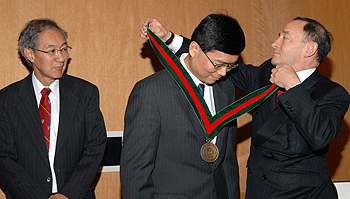At a Nov. 29 ceremony in Uncas A. Whitaker Hall, Lihong Wang became the first Gene K. Beare Distinguished Professor of Biomedical Engineering in the School of Engineering & Applied Science (SEAS). Wang is a leading researcher on new methods of cancer imaging.
“The late Gene Beare was a very generous person, and Washington University is fortunate to be among the many organizations that benefited from his philanthropy,” Chancellor Mark S. Wrighton said. “This gift will contribute greatly to advancing the tremendous research and important discoveries taking place in the Department of Biomedical Engineering.”

Mary Sansalone, Ph.D., dean of the engineering school, commented at the installation ceremony: “Unfortunately, I did not have the opportunity to meet Gene Beare, but through this professorship and his many friends at Washington University, he will be remembered always for his generous spirit and his commitment to the work we do,” she said.
The sentiment was echoed at the installation by Frank Yin, M.D., Ph.D., the Stephen F. and Camilla T. Brauer Distinguished Professor of Biomedical Engineering and chair of the department: “Gene Beare will always have a presence in our department and be known for his support for the advancement of biomedical research.”
Beare passed away in 2005, but the installation was attended by his daughters, Joanne and Gail, the latter presenting a personal reflection of her father.
Despite modest beginnings and a number of setbacks early in life, Beare became a leader in the telephone industry. He earned a bachelor’s degree in mechanical engineering from WUSTL in 1937 and a business degree from Harvard University two years later.
A summer job at Southwestern Bell led to an interest in the telephone field, and after graduation from Harvard, he joined Automatic Electric Co., a multinational manufacturer of office equipment, instruments for the independent (non-Bell) industry and military communications equipment.
When Automatic Electric merged with General Telephone Co. in 1959, Beare was chosen to head its Sylvania International component. Two years later, he was promoted to president of Sylvania Electric Products.
Surviving a plane crash, he continued his rise and, in 1969, became executive vice president and director of General Telephone and Electronics (GTE). In 1972, he came to St. Louis to help lead General Dynamics Corp., from which he retired in 1980.
Throughout his long career, Beare served as a leader in professional associations and served on a number of boards. He has been honored by WUSTL, first in 1981, with an Alumni Achievement Award, and in 2001, with the Dean’s Award, both from SEAS. His support for his alma mater includes earlier contributions to Whitaker Hall.
Wang joined the SEAS biomedical engineering faculty last year, after many years at Texas A&M University as a professor of biomedical engineering and electrical engineering.
His research has made seminal gains regarding a variety of forms of tomography, including ultrasound-modulated optical tomography, photoacoustic tomography, thermoacoustic tomography, modeling of light transport in biological tissue and polarization-sensitive optical coherence tomography. His research team created a model of photon transport in scattering media, called the Monte Carlo model, which is widely used.
His work has appeared in more than 120 scholarly journals and he is a frequent speaker at major conferences and symposia. He has received numerous professional awards from the National Institutes of Health (NIH), the National Science Foundation (NSF) and several faculty awards from Texas A&M.
His research on non-ionizing biophotonic imaging has been supported by the NIH, NSF, the U.S. Department of Defense, The Whitaker Foundation and the National Institute of Standards and Technology.
In addition, he chairs the International Biomedical Optics Society, and is a fellow of the American Institute for Medical and Biological Engineering, the Optical Society of America, the Institute of Electrical and Electronics Engineers and the Society of Photo-Optical Instrumentation Engineers.
He serves on a number of editorial boards and has reviewed for more than 30 journals in his field. Furthermore, Wang serves on scientific advisory boards for three corporations.
A native of Guangshui, in Hubei province, China, he earned bachelor’s and master’s degrees of science from Huazhong University of Science and Technology in 1984 and 1987, respectively. He earned a doctorate in electrical engineering from Rice University in 1992.
Prior to Texas A&M, he conducted research at the University of Texas’ MD Anderson Cancer Center.